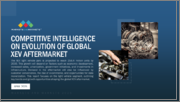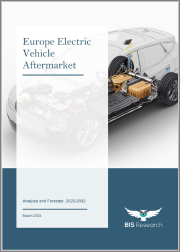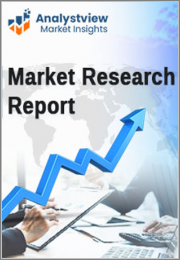
|
시장보고서
상품코드
1711379
세계의 xEV(전기차) 애프터마켓의 진화에 관한 경쟁 인텔리전스 예측(-2035년) : 추진 방식별, 컴포넌트별, 지역별Competitive Intelligence on the Evolution of Global XEV Aftermarket by Propulsion, Components, Region - Global Forecast to 2035 |
||||||
세계의 xEV(전기차) 애프터마켓은 2024년에 590억 달러, 2035년에는 1,950억 달러에 달할 것으로 예측되며, 2024-2035년까지 CAGR은 11.5%로 보이고 있습니다.
xEV 애프터마켓은 주요 지역에서의 XEV 보급률의 상승, 평균 연령과 연간 주행거리의 상승, 애프터마켓에서 신규 서비스 수요 등 다양한 요인에 의해 성장이 전망되고 있습니다.
| 조사 범위 | |
|---|---|
| 조사 대상연도 | 2024-2035년 |
| 기준연도 | 2024년 |
| 예측 기간 | 2024-2035년 |
| 대상 대수 | 수량(대) 및 금액(100만 달러) |
| 부문별 | 추진 방식별, 컴포넌트별, 지역별 |
| 대상 지역 | 중국, 아시아태평양, 유럽, 북미, 기타 지역 |
전기자동차(EV)는 고유한 기술적, 운영적 특성으로 인해 애프터마켓 서비스에 새로운 전환기를 맞이하고 있습니다. 내연기관 엔진에서 전기 파워트레인으로의 전환은 혁신적인 서비스 모델을 도입하는 한편, '4R' 원칙(수리, 재사용, 재활용, 재생산)과 관련된 기회를 확대할 것으로 보입니다. 이동식 서비스 유닛이 각광을 받아 EV의 주문형 유지보수 및 진단을 제공하여 소유자의 다운타임을 줄일 수 있습니다. 오래된 차량을 전기 시스템으로 개조하여 클래식 자동차나 노후화된 차량에 새로운 생명을 불어넣고, 지속가능성과 맞춤화를 결합하여, 움직이는 부품이 적기 때문에 EV의 정기적인 유지보수가 간소화되기는 하지만, 고전압 시스템 및 소프트웨어 업데이트와 관련된 전문 기술이 필요하게 될 것입니다. 기술이 요구되며, 숙련된 기술자의 틈새 시장이 형성될 것입니다. 배터리의 세컨드 라이프 적용이 중요한 동향으로 부상하고, 사용한 전기자동차 배터리를 가정이나 전력망의 에너지 저장에 재사용함으로써 전기자동차 배터리의 가치를 차량 외부로 확대할 것입니다. 또한 모터, 컨트롤러, 충전기 등 EV 부품의 재제조도 비용 효율적인 대체품에 대한 요구와 순환 경제의 실천에 힘입어 성장할 것으로 보입니다. 이러한 발전은 기술 주도형 솔루션과 지속가능한 혁신을 결합하여 애프터마켓의 전망을 재정의할 것입니다.
자동차 산업이 전동화로 전환됨에 따라 OEM은 전기자동차 수리 및 유지보수에서 안정적인 수입원을 확보하기 위해 전략적 방향 전환을 하고 있습니다. 기존 자동차와 달리 전기자동차는 기계적인 유지보수 빈도가 낮기 때문에 OEM은 배터리 상태 모니터링, 소프트웨어 업데이트, 전기 구동계의 특수한 수리 등 고부가가치 서비스에 집중하고 있습니다. 이러한 변화에서 디지털화는 매우 중요한 역할을 하며, OEM은 OTA(Over-The-Air) 업데이트를 활용하여 지속적인 개선을 제공하고, 원격으로 문제를 해결하며, 구독 기반 기능을 제공함으로써 고객 충성도를 높이고 지속적인 매출을 창출할 수 있습니다. 지속적인 매출을 창출할 수 있습니다. 텔레매틱스 및 커넥티드 차량 플랫폼을 통해 OEM은 차량 성능에 대한 실시간 데이터를 수집하고, 유지보수 필요성을 예측하고, 개인화된 서비스 패키지를 제공함으로써 타사 정비소에 대한 의존도를 낮출 수 있습니다. 수 있습니다. 또한 OEM은 배터리 팩 정비와 같은 복잡한 수리를 관리하기 위해 인증된 서비스 네트워크와 교육 프로그램을 구축하고, 배터리 재활용 및 세컨드 라이프 용도를 위한 파트너십을 모색하고 있습니다. 디지털 툴을 통합함으로써 OEM은 운영을 간소화하고 비용을 절감하며 EV 생태계에서 엔드 투 엔드 솔루션 프로바이더로 자리매김할 수 있습니다.
EV 서비스 시장이 진화함에 따라 주문자 상표 부착 제품 제조업체(OEM)와 독립 애프터마켓(IAM) 업체들은 각자의 전략을 수립하여 발판을 마련하고 있으며, OEM은 자체 소프트웨어, 진단, 배터리 시스템 관리를 강화하고 OTA(Over-The-Air) 업데이트와 같은 디지털화를 통해 고객을 확보하고 고부가가치 수리를 지배하고 있습니다.(OTA) 업데이트 및 텔레매틱스와 같은 디지털화를 통해 고객을 확보하고 고부가가치 수리를 장악하고 있으며, IAM은 독점적인 서비스 네트워크를 구축하고, 인증된 교육을 제공하고, 유지보수를 보증으로 연결하여 EV 소유자가 자사 생태계를 신뢰하도록 신뢰하도록 하고 있습니다. 반대로 IAM은 이러한 OEM의 아성을 무너뜨려야 하는 문제에 직면해 있습니다. 이에 대응하기 위해 IAM은 리버스 엔지니어링 툴에 투자하고, 제3자 진단 솔루션을 개발하고, EV의 데이터와 소프트웨어 코드에 접근할 수 있는 '수리권' 규제를 요구하기 위해 로비 활동을 펼칠 것으로 보입니다. 보증기간 외의 가격에 민감한 소비자들에게 가격 경쟁력 있는 제품에 중점을 두어 어필할 것입니다.
일부 IAM은 인증된 예비 부품 및 서비스 계약을 위해 OEM과 제휴하여 경쟁과 공존의 균형을 맞추는 경우도 있으며, IAM은 오래된 EV의 개조 및 OEM의 우위가 사라지고 있는 보증 기간이 지난 차량의 서비스 분야에서 틈새 시장을 개발할 수 있습니다. 한편, 지속가능성에 대한 소비자의 요구는 배터리 세컨드 라이프 프로그램을 제공하는 OEM과 지역 밀착형 재활용 솔루션을 제공하는 IAM 모두에게 혁신을 요구할 수 있습니다. 이 싸움은 디지털 접근, 규제 변화, 소프트웨어 업데이트 및 고전압 시스템 수리 등 전기자동차 고유의 요구사항에 대한 적응 능력에 달려있습니다.
이 시장 분석은 xEV 애프터마켓 시장을 다루고 있으며, 판매와 xEV에 초점을 맞추었습니다. 또한 2024년 xEV 애프터마켓의 부품 수요를 조사했습니다. 이 보고서는 xEV 애프터마켓 분야를 주도하는 동향을 조사하고 2035년까지 업계에 영향을 미칠 요인을 분석합니다. 지역 간 평균 주행거리와 평균 연령, E-Commerce와 디지털화가 애프터마켓에 미치는 영향, OES V IAM 벤치마킹 전략 등 다양한 요소를 다루고 있습니다.
이 보고서는 2024년 xEV 애프터마켓과 그 하위 부문의 판매량 및 판매량에 대한 가장 근접한 추정치에 대한 정보를 제공하여 시장 리더와 신규 시장 진출기업에게 도움이 될 것입니다. 이 보고서는 이해관계자들이 경쟁 구도를 이해하고, 비즈니스를 더 잘 포지셔닝하고, 적절한 시장 진출 전략을 계획하는 데 필요한 더 많은 정보를 얻을 수 있도록 돕습니다. 또한 이해관계자들이 시장의 맥박을 이해하고 주요 시장 성장 촉진요인, 과제 및 기회에 대한 정보를 제공하는 데 도움이 될 것입니다.
목차
제1장 개요
제2장 조사 목적, 범위, 조사 방법
제3장 거시경제 분석과 규제 분석
- 지역별 GDP 성장 예측
- 지역별 세계 인플레이션율
- 2030년까지의 세계 원유가격과 리튬이온 배터리 가격의 동향
제4장 XEV PARC와 연령 경향분석
- XEV PARC, 지역별·추진 방식별
- XEV PARC 분석, 추진 방식별·지역별
- XEV 연비 동향
- XEV 평균 연수의 동향
제5장 XEV 컴포넌트 애프터마켓
- 세계 : XEV 애프터마켓(추진 방식별, 지역별, 컴포넌트별)
- 유럽 : XEV 애프터마켓(추진 방식별, 컴포넌트별)
- 북미 : XEV 애프터마켓(추진 방식별, 컴포넌트별)
- 중국 : XEV 애프터마켓(추진 방식별, 컴포넌트별)
- 아시아태평양(중국 제외) : XEV 애프터마켓(추진 방식별, 컴포넌트별)
- 기타 지역 : XEV 애프터마켓(추진 방식별, 컴포넌트별)
제6장 하이브리드차와 전기자동차용 신규 서비스
- 배터리 재활용
- EV개조
- 배터리 재사용
- EV 서비스의 정비와 수리
- 모바일 서비스 유닛
- EV 충전 서비스
제7장 OEM XEV 애프터 세일즈 전략
제8장 OES와 IAM 벤치마킹
제9장 주요 성장 기회와 제안
제10장 결론과 요약
KSA 25.05.08The global xEV aftermarket was USD 59 billion in 2024 and is projected to reach USD 195.0 billion in 2035, witnessing a CAGR growth of 11.5% from 2024 to 2035. The xEV aftermarket is expected to experience growth driven by various factors, such as the rising penetration of XEVs across the key regions, rising average age and miles traveled in a year, and demand for emerging services in the aftermarket.
| Scope of the Report | |
|---|---|
| Years Considered for the Study | 2024-2035 |
| Base Year | 2024 |
| Forecast Period | 2024-2035 |
| Units Considered | Volume (Units) and Value (USD Million) |
| Segments | by Propulsion, Components, Region (China, APAC excl. China, Europe, NA, RoW) - Global Forecast to 2035 |
| Regions covered | China, APAC, Europe, NA, RoW |
"EV to bring a very transformative change in the automotive aftermarket."
Electric vehicles (EVs) are poised to usher in a transformative era for aftermarket services, driven by their unique technological and operational characteristics. The shift from internal combustion engines to electric powertrains will expand opportunities around the "4R" principles-repair, reuse, recycle, and remanufacture-while introducing innovative service models. Mobile service units will gain prominence, offering on-demand maintenance and diagnostics for EVs, reducing downtime for owners. Retrofitting older vehicles with electric systems will breathe new life into classic cars and aging fleets, blending sustainability with customization. Routine EV maintenance, though simpler due to fewer moving parts, will demand specialized skills in high-voltage systems and software updates, creating a niche for skilled technicians. Battery second-life applications will emerge as a key trend, repurposing used EV batteries for energy storage in homes or grids, extending their value beyond the vehicle. Additionally, EV part remanufacturing-such as motors, controllers, and chargers-will grow, fueled by the need for cost-effective replacements and circular economy practices. Together, these developments will redefine the aftermarket landscape, blending tech-driven solutions with sustainable innovation.
"OEMs strategizing to become a major stakeholder in xEV aftermarket."
Original Equipment Manufacturers (OEMs) are strategically pivoting to secure stable income streams from EV repair and maintenance as the automotive industry transitions to electrification. Unlike traditional vehicles, EVs require less frequent mechanical upkeep, prompting OEMs to focus on high-value services like battery health monitoring, software updates, and specialized repairs for electric drivetrains. Digitalization plays a pivotal role in this shift, enabling OEMs to leverage over-the-air (OTA) updates to deliver continuous improvements, troubleshoot issues remotely, and offer subscription-based features-creating recurring revenue while enhancing customer loyalty. Telematics and connected vehicle platforms allow OEMs to collect real-time data on vehicle performance, predict maintenance needs, and offer personalized service packages, reducing reliance on third-party repair shops. Additionally, OEMs are establishing certified service networks and training programs to retain control over complex repairs, such as battery pack servicing, while exploring partnerships for battery recycling and second-life applications. By integrating digital tools, OEMs can streamline operations, cut costs, and position themselves as end-to-end solution providers in the EV ecosystem.
"xEVs to intensify the competition between IAM and OES players"
As the EV servicing market evolves, Original Equipment Manufacturers (OEMs) and Independent Aftermarket (IAM) players are crafting distinct strategies to secure their foothold. OEMs are doubling down on their control over proprietary software, diagnostics, and battery systems, using digitalization-like over-the-air (OTA) updates and telematics-to lock in customers and dominate high-value repairs. They're building exclusive service networks, offering certified training, and tying maintenance to warranties, ensuring EV owners rely on their ecosystem. Conversely, IAMs face the challenge of breaking this OEM stronghold, particularly around proprietary software. To compete, IAMs are likely to invest in reverse-engineering tools, develop third-party diagnostic solutions, and lobby for "right-to-repair" regulations to access EV data and software codes. They'll focus on cost-competitive offerings, such as refurbished parts, battery remanufacturing, and mobile repair units, appealing to price-sensitive consumers outside warranty periods.
Collaboration could also emerge, with some IAMs partnering with OEMs for authorized spare parts or service contracts, balancing competition with coexistence. IAMs might carve niches in retrofitting older EVs or servicing out-of-warranty vehicles, where OEM dominance wanes. Meanwhile, consumer demand for sustainability could push both to innovate-OEMs with battery second-life programs and IAMs with localized recycling solutions. The battle will hinge on digital access, regulatory shifts, and the ability to adapt to EV-specific needs like software updates and high-voltage system repairs.
Research Coverage:
The market analysis encompasses the xEV aftermarket market, focusing on the sales & xEVs . Additionally, it examines the demand for components in the xEV aftermarket in 2024. The report delves into the trends propelling the xEV aftermarket sector, analyzing factors influencing the industry by 2035. The study encompasses a broad range of factors like average mileage & average age across regions, the impact of e-commerce and digitalization on the aftermarket, OES V IAM benchmarking strategies, etc.
Report Scope
The report will help market leaders and new entrants with information on the closest approximations of the sales & parc numbers for the xEV Aftermarket in 2024 and their subsegments. This report will help stakeholders understand the competitive landscape and gain more insights to better position their businesses and plan suitable go-to-market strategies. The report also helps stakeholders understand the market pulse and provides information on key market drivers, restraints, challenges, and opportunities.
The report provides insights on the following pointers:
- Analysis of regional parc volume and regional components demand in XEVs.
- Analysis of key emerging services (battery recycling, retrofitment, battery second life usage, predictive maintenance, remote onboard diagnostics, integration of sustainability, mobile service units, EV charger aggregators, etc.).
- Analysis of OEM XEV Aftersales strategies, which includes aftersale strategies and business models offered by different OEMs
- OES Vs IAM Benchmarking: Detailed insights OES vs Aim penetration in the EV maintenance space, OEM vs IAM customer retention and acquisition strategies, details about infrastructure and investments.
- Market Development: Comprehensive information about lucrative markets - the report analyses the XEV aftermarket across varied regions
- Competitive Assessment: This section assesses the market shares, growth strategies, and service offerings of leading players across xEV segments. The report also helps stakeholders understand the pulse of the aftermarket components and services market and provides them with information on key market drivers, challenges, and opportunities.
TABLE OF CONTENTS
1 EXECUTIVE SUMMARY
- 1.1 GLOBAL LIGHT VEHICLE PARC TRENDS
- 1.2 ICE VS XEV AFTERMARKET REVENUE ANALYSIS
- 1.3 ICE VS XEV COMPONENTS MAINTENANCE COST PER MILE AND REPLACEMENT INTERVAL
- 1.4 AFTERMARKET REVENUE IMPACT DUE TO PENETRATION OF BEVS
- 1.5 XEV COMPONENTS REPLACEMENT COST ANALYSIS
- 1.6 EMERGING SERVICES FOR HYBRID AND ELECTRIC VEHICLES
2 STUDY OBJECTIVES, SCOPE, AND METHODOLOGY
- 2.1 STUDY SCOPE
- 2.2 STUDY OBJECTIVES AND METHODOLOGY
3 MACROECONOMIC ANALYSIS & REGULATORY ANALYSIS
- 3.1 GDP GROWTH PROJECTIONS BY REGION
- 3.2 GLOBAL INFLATION RATE BY REGION
- 3.3 GLOBAL CRUDE OIL PRICE VS. LITHIUM-ION BATTERY PRICE TRENDS TILL 2030
4 XEV PARC AND AGE TREND ANALYSIS
- 4.1 XEV PARC BY REGION & PROPULSION
- 4.2 XEV REGIONAL PARC ANALYSIS BY PROPULSION
- 4.3 XEV MILEAGE TRENDS
- 4.4 XEV AVERAGE AGE TRENDS
5 XEV COMPONENTS AFTERMARKET
- 5.1 GLOBAL: XEV AFTERMARKET BY PROPULSION, REGION & COMPONENT
- 5.2 EUROPE: XEV AFTERMARKET BY PROPULSION & COMPONENT
- 5.3 NORTH AMERICA: XEV AFTERMARKET BY PROPULSION & COMPONENT
- 5.4 CHINA: XEV AFTERMARKET BY PROPULSION & COMPONENT
- 5.5 APAC (EXCL. CHINA): XEV AFTERMARKET BY PROPULSION & COMPONENT
- 5.6 ROW: XEV AFTERMARKET BY PROPULSION & COMPONENT
6 EMERGING SERVICES FOR HYBRID & ELECTRIC VEHICLES
- 6.1 BATTERY RECYCLING
- 6.2 EV RETROFITMENT
- 6.3 BATTERY SECOND LIFE USAGE
- 6.4 EV SERVICES IN THE MAINTENANCE AND REPAIRS
- 6.5 MOBILE SERVICE UNITS
- 6.6 EV CHARGING SERVICES













